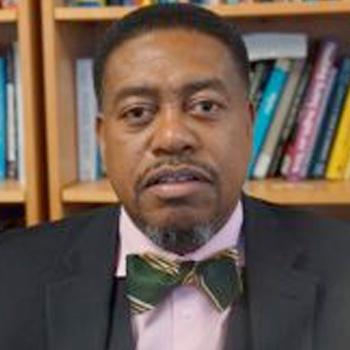Terrance M. Blackman
Terrance M. Blackman
Assistant Professor, Education Research, Policy & Practice (Mathematics), University of Denver
MLK Visiting Assist. Prof. 2012-2013
Hosted by Prof. David Vogan, Department of Mathematics

Bio
Terrance Blackman is a number theorist and an Assistant Professor in Education Research, Policy & Practice (Mathematics) at University of Denver. His research interests are: aspects of the Jacquet-Langlands correspondence in the Langlands program; diversity in mathematics and science.
Prof. Blackman holds a BSc in Mathematics (Cum laude, 1991) from Brooklyn College, CUNY. He earned his MPhil (2000) and PhD (2011) degrees in Mathematics from The Graduate School and University Center, CUNY. His dissertation was titled "On the Arithmetic and Geometry of Quaternion Algebras: A spectral correspondence for Maass waveforms." Prof. Blackman's research since has focused on the “Jacquet-Langlands correspondence” for GL(2).
Prof. Blackman was born in Georgetown, Guyana and is "an old boy of the famed Guyanese high school, Queens College". He is actively engaged in research on pedagogical the issues which surround the teaching and learning of mathematics in urban, majority African-American settings. As Program Leader for Legacy Pathways, he utilizes "technology, research, innovative ideas, hands-on learning experiences, and best practices to develop and sustain lifelong learners". Prof.Blackman
In addition to his appointment at the University of Denver, he is a tenured lecturer in the Department of Mathematics at Medgar Evers College CUNY. He has taught at other institutions throughout the CUNY system: Kingsborough Community College, John Jay College, Lehman College. Prof. Blackman has also been faculty fellow at The Graduate School and University Center, CUNY; Boston University; and Mount Holyoke College.
As an MLK Visiting Assistant Professor Prof. Blackman worked closely with Prof. David Vogan and participated in the Department of Mathematics' Lie group and number-theory seminars.
Publications
Mathematics
"On the Arithmetic and Geometry of Quaternion Algebras: A spectral correspondence for Maass waveforms." Thesis (Ph.D.) City University of New York. 2011. 95 pp. ISBN: 978-1124-71850-7 ProQuest LLC
Education and Math Education
Contributor: Pedagogy and Student Services for Institutional Transformation: Universal Instructional Design Implementation Guidebook II for Faculty and Staff, pgs 42-45, Emily Go and Jeanne L. Higbee Editors, 2008.
Web
Blog, "terrence's take", on Mathematics and the African American community.
Maple Guide Book: This manual is designed to serve as a Maple computer algebra system resource for both instructor and student in a standard undergraduate precalculus and calculus courses. It presents concepts in an order that closely follows the standard syllabi in these courses and provides a brief introduction to those aspects of the Maple software program most useful to students in these areas. To appear in Summer 2013.
Interests
Mathematics Research
I am a number theorist. I work on aspects of the Jacquet-Langlands correspondence in the Langlands program. To be specific: I study the discrete spectrum and the eigenfunctions of the Laplacian for a special class of "arithmetic'' surfaces, namely those with constant negative curvature, finite area and a finite number of "punctures'' or "cusps''. These are of fundamental interest in mathematics and physics. Such surfaces are called hyperbolic and when we "puncture'' them we have essentially removed a point from the surface and pulled it away to infinity. The "arithmeticity'' of the surface relates to its association with subgroups of the modular group. The eigenfunctions are called Maass waveforms and they remain a mystery some now sixty years after their discovery. No explicit construction exists for any of these functions on the full modular group. Their existence and information about their eigenvalues come mostly from the Selberg trace formula and from conjectures supported by exhaustive numerical computations. Maass wave forms, non-Euclidean sine waves, arise naturally in such seemingly diverse fields as number theory, dynamical systems, statistical mechanics, quantum chaos in theoretical physics and cosmology. I investigate spectral correspondences predicted by the Jacquet Langlands Correspondence between the spectra of some finite area arithmetic surfaces without "punctures'' and a related class of finite area surfaces with "punctures".
Math Education
I also work on promoting diversity in mathematics and science. My emerging research agenda is grounded in the pedagogical, content, soccio-economic, cultural and structural issues which inform the low rates of mathematics achievement by students of color. I want to increase the participation of underrepresented minorities in mathematics and science from grade school to graduate school. I focus on:
- (i) Strategies which enhance the mathematical preparedness of underrepresented students for college level mathematics and those which support access to meaningful mathematics while in college;
- (ii) Understanding and implementing strategies which foster retention and persistence in mathematics for all students but particularly those from underrepresented communities;
- (iii) Developing and understanding meaningful and innovative uses of emerging instructional technologies in support of mathematics instruction.
- (iv) Community/Social infrastructure that supports mathematics achievement in underrepresented communities, in particular, the challenges and opportunities for the development of institutional partnerships aimed at connecting mathematics to the community specifically the creating and sustaining of links between Middle Schools, High Schools, Two and four year College and Research Institutions in a particular geographic region.
- (v) Strategies to support the participation of members of underrepresented communities in research mathematics.
- (vi) The use of number theory in the teaching and learning of mathematics and in mathematics education research.
- (vii) Here are three resources that inform my thinking on mathematics and mathematics education: